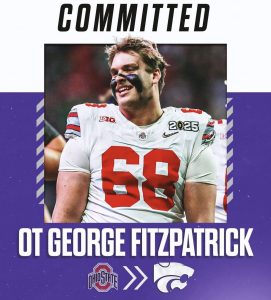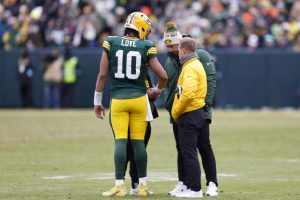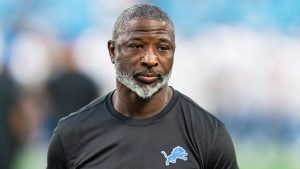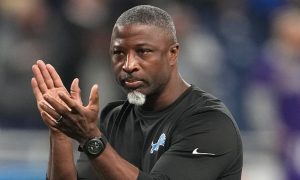In a move that has sent shockwaves through the football world, the Tigers have secured one of the most highly sought-after wide receivers with a substantial $17.7 million deal. This signing marks a significant milestone for the team, both in terms of strengthening their offensive lineup and sending a clear message to the league that they are determined to contend for a championship in the near future.
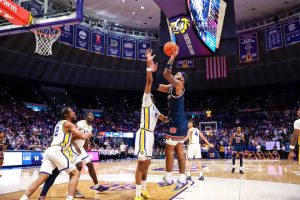
The $17.7 million contract is a game-changer, not only because of the financial commitment but also due to the player’s potential to elevate the Tigers’ offense. As the team moves forward into the next season, this deal could prove to be a pivotal moment in their bid for success. The following explores the significance of this signing, the player’s impact on the team, and what this move means for the Tigers’ future.
A Major Acquisition
When the Tigers first entered the offseason with a focus on bolstering their offensive depth, they had one clear priority: finding a reliable and explosive wide receiver to pair with their current roster. Despite having a solid receiving corps, the team was missing that one dynamic playmaker who could stretch the field and make crucial plays in key moments.
Enter the newly signed wide receiver. Known for his blazing speed, exceptional route running, and ability to make spectacular catches in clutch situations, he became an immediate target for the Tigers’ front office. After months of negotiations and competitive interest from other teams, the Tigers secured the player with a lucrative contract, locking him down for the foreseeable future.
The $17.7 million deal underscores the team’s commitment to improving their offensive game. In professional football, wide receivers are often the centerpiece of high-powered offenses, and the Tigers clearly see this player as the catalyst they need to reach the next level. With this kind of investment, the Tigers are signaling that they are ready to compete with the league’s best, and they believe that this wide receiver is the key to unlocking their full potential.
The Player’s Skillset and Impact
At the heart of this monumental deal is the wide receiver’s exceptional skill set. This player isn’t just another big name—he is a proven talent who can change the course of a game with a single play. Over the course of his career, he has amassed impressive statistics, including numerous 1,000-yard seasons and a reputation for making spectacular catches in the most high-pressure moments.
What sets this player apart is his ability to create separation from defenders with both speed and agility. Whether it’s a deep bomb down the sideline or a quick slant across the middle, he has the versatility to thrive in any offensive scheme. His strong hands and ability to track the ball in the air make him a valuable asset, especially in third-down and red-zone situations, where his presence can give quarterbacks a reliable target in critical moments.
In addition to his individual skills, this wide receiver is known for his leadership qualities and work ethic. His approach to the game has earned him the respect of teammates, coaches, and opposing players alike. That kind of character is priceless in the locker room, where a strong team dynamic is often just as important as individual talent.
For the Tigers, acquiring a player of this caliber is a massive win. His arrival immediately strengthens their receiving corps, providing their quarterback with a go-to option who can make plays all over the field. With defenses now having to account for this player, it opens up opportunities for other offensive weapons to shine, creating a more balanced and dangerous attack overall.
Financial Implications of the Deal
The $17.7 million contract is a significant financial commitment, but it reflects the value the Tigers place on this wide receiver. The deal structure likely includes both guaranteed money and performance incentives, which would further align the player’s goals with the team’s success. The financial commitment is indicative of the Tigers’ strategy to build a winning team around the concept of star players and high-performing individuals.
While the deal represents a sizable investment, it also provides a window into the financial priorities of the Tigers’ front office. In today’s NFL, teams with the resources to sign top-tier talent must also balance their budgets in a way that allows for sustained success. This signing is part of a larger effort to assemble a roster capable of competing with the league’s best, and the Tigers seem willing to make the financial sacrifices necessary to reach that goal.
It’s worth noting that this $17.7 million deal doesn’t just benefit the Tigers in terms of the on-field performance of the wide receiver. The move also carries significant off-field implications. A high-profile acquisition like this draws attention from fans, media, and sponsors alike, which can translate into increased ticket sales, merchandise, and television revenue. In essence, the investment in this wide receiver could have long-term financial benefits for the franchise as it builds a stronger brand and enhances its fanbase.
What This Means for the Tigers’ Future
The signing of this wide receiver represents more than just a short-term boost for the Tigers; it signals their long-term ambitions as well. The Tigers are positioning themselves as a team to watch, with a roster that now includes one of the league’s premier playmakers. By making such a significant financial investment, they are sending a clear message to both fans and competitors that they are ready to compete for championships.
This deal could also have a ripple effect on the team’s other players. For instance, the quarterback—who has struggled with inconsistency at times—will now have a reliable, top-tier target at his disposal. This could help him gain confidence, improve his decision-making, and, ultimately, elevate the entire offense. Additionally, this wide receiver’s presence will likely make other positions—such as running back and tight end—more effective as defenses will be forced to spread out to cover a potent passing attack.
Moreover, the Tigers now have a valuable asset that could be used in future trades or negotiations if needed. Should the team decide to pursue additional pieces for their roster in the coming seasons, the presence of such a high-profile player could be leveraged as part of a larger strategy. The wide receiver’s value extends beyond his on-field performance—he is also a valuable piece in the team’s larger vision of becoming a perennial contender.
Final Thoughts
In conclusion, the Tigers’ acquisition of a wide receiver with a $17.7 million deal marks a defining moment for the franchise. This move demonstrates the team’s commitment to building a competitive roster and signals a future in which the Tigers are aiming for a championship. With an explosive talent on board, they now possess a player who can make an immediate and lasting impact on the field.
As the Tigers prepare for the upcoming season, this signing will undoubtedly be one of the most talked-about moves in the league. Whether it’s helping the team secure key victories in crucial games or drawing in new fans and sponsorships, the $17.7 million investment is one that could pay dividends for years to come. With a clear vision in mind and a star player on their roster, the Tigers are positioning themselves for success, and this wide receiver could be the key to unlocking their full potential.
